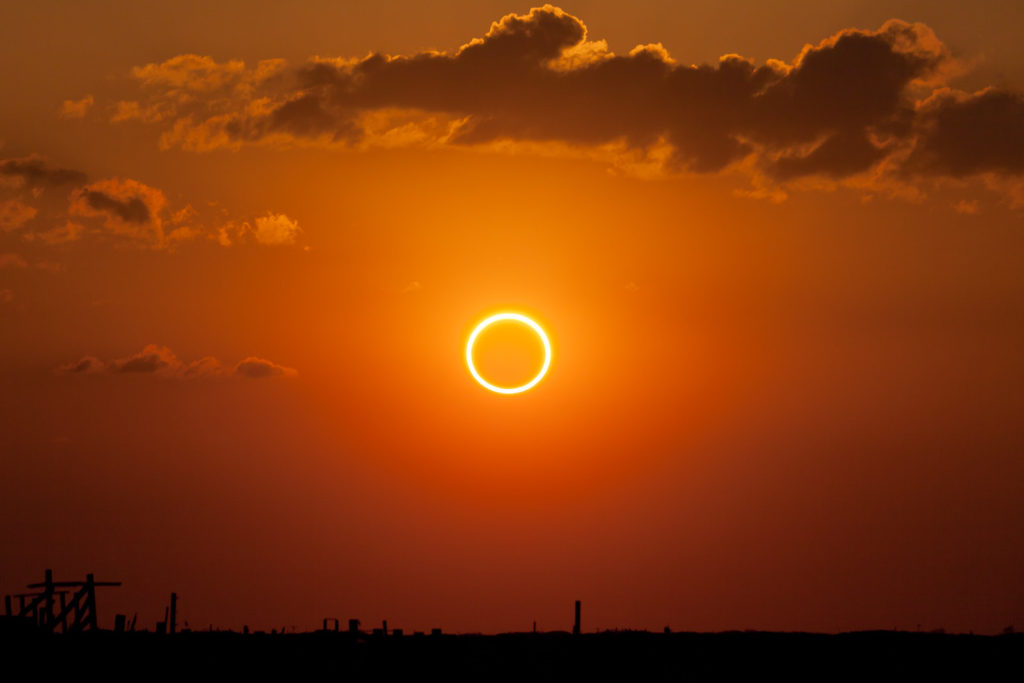
A change of seasons arrives as stargazers in the southern hemisphere enjoy long nights to make up for cooling temperatures, while northerners enjoy summer at the expense of much shorter nights. (Where I live, in Calgary, there’s no astronomical darkness at all until mid-July)!
But there’s plenty to see this month as Jupiter and Saturn grow in brightness and size, rising in the southeast after midnight. Mars slowly eases itself westwards towards the sun after more than a year in the night sky, but it goes out in style as it passes through the Beehive star cluster late in the month. Mercury is lost in the sun’s glare for most of June. But Venus sits low and bright in the evening sky over the northwestern horizon after sunset at its most northerly declination of the year. A lucky few get to enjoy a rare annular solar eclipse, while millions more can grab a pair of ‘solar glasses’ and see a partial solar eclipse over much of northeastern North America. Here’s what to see in the night (and day) sky this month…
2 June 2021. Last Quarter Moon, 07:24 UT
2 June. Look for the last-quarter moon, Jupiter, and Saturn gathered in a shallow arc in the southeastern sky before sunrise.

10 June. New Moon, 10:53 UT
10 June. Two weeks after the ‘super moon’ lunar eclipse, when the moon was closest to Earth in its orbit, a solar eclipse passes across the northeastern reaches of North America. However, during this eclipse, the moon is at its further point from Earth and does not appear large enough to cover the entire face of the sun. The result? An annular solar eclipse.
Not many will see the full annular eclipse. The event starts at sunrise in northern Ontario (not far from my hometown of Thunder Bay) and runs over Hudson’s Bay, northern Quebec, Baffin Island, and, eventually, the North Pole! However, millions will be able to see an impressive partial solar eclipse in the hour or so after sunrise. That includes cities such as Chicago, Philadelphia, Washington DC, New York, Montreal, Ottawa, and Toronto. You will need a safe solar filter to watch the moon ‘take a bite’ out of the sun as it rises. The event also offers a good chance for careful astrophotographers to captures some dramatic images. Check timing for your location at this link.

11 June. One day after the annular solar eclipse, an extremely slender crescent moon comes into the evening sky about two degrees to the right of brilliant Venus. Look for them just over the north-northwestern horizon after sunset. Only 3% illuminated, the Moon will be very difficult to see in the bright late-spring twilight in the northern hemisphere. A pair of binoculars, or even better, a wide-field eyepiece in a small telescope can offer a better view of both Moon and planet. Wait until the sun is below to horizon to attempt this observation. On June 12, the growing moon will lie nearly ten degrees to the upper left of Venus.

13 June. As darkness falls, look for a slender waxing crescent moon within a few degrees of Mars and the Beehive star cluster (M44) in the constellation Cancer.
18 June. First Quarter Moon, 03:54 UT
21 June. The June solstice arrives at 03:32 UT. This marks the beginning of summer in the northern hemisphere and winter in the south, and the longest and shortest days of the year, respectively, for each hemisphere.
21 June. Look for brilliant Venus low over the north-northwestern horizon just five degrees from the star Pollux in the constellation Gemini.
21 June. Jupiter begins its retrograde motion moving westward from night to night against the background stars on its way to opposition in August.
22 June. The waxing gibbous moon lies about three degrees from the bright star Antares in the constellation Scorpius.
23 June. The fading planet Mars makes its way into the Beehive star cluster in the constellation Cancer. For northern observers, the bright mid-summer twilight obscures the view, so this is a more promising event for southern-hemisphere observers. A pair of binoculars or a telescope, along with a clear view of the horizon, are all but essential. Still, it’s worth the effort to see the spectacle of red-orange Mars surrounded by a little cloud of faint stars.
24 June. Full Moon, 18:40 UT
28 June. The waning gibbous moon lies between the planets Jupiter and Saturn low over the east-southeastern horizon before dawn.
